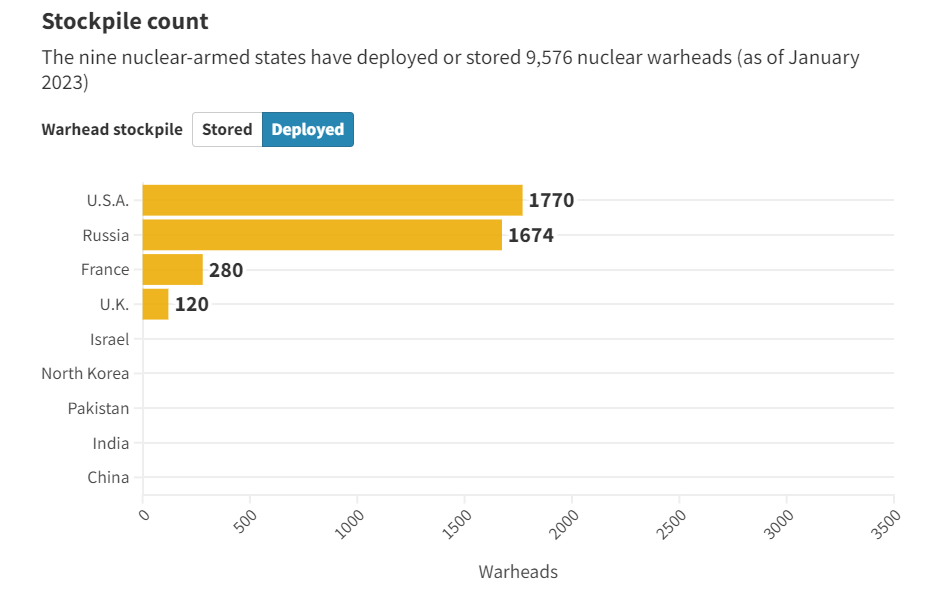SIPRI Yearbook 2023 | 15 Jun 2023
Why in News?
Recently, Stockholm International Peace Research Institute (SIPRI) Yearbook 2023 revealed that China could potentially have as many Intercontinental Ballistic Missiles (ICBMs) as U.S. or Russia by the end of the decade.
- Russia has the highest number of stored nuclear arsenals followed by US and China while the US has deployed the highest number of nuclear arsenals followed by Russia and France.
What SIPRI Reveal About Nuclear Arsenals?
- Global Nuclear Arsenals:
- Modernization and Expansion:
- The nine nuclear-armed states, including the United States, Russia, and China, continue to modernize and expand their nuclear arsenals, deploying new nuclear-armed or nuclear-capable weapon systems in 2022.
- Other nuclear-armed countries are UK, France, India, Pakistan, the North Korea and Israel
- Total Global Inventory:
- As of January 2023, the total global inventory of warheads is estimated at 12,512, with approximately 9,576 warheads held in military stockpiles for potential use.
- Modernization and Expansion:
- Dominance of Russia and U.S.:
- 90% of all Nuclear Weapons:
- Russia and the United States possess almost 90% of all nuclear weapons, with relatively stable sizes of their respective nuclear arsenals.
- Arms Control Concerns:
- Transparency and dialogue regarding nuclear forces declined between Russia and the United States following Russia's invasion of Ukraine.
- The suspension of the strategic stability dialogue and the Treaty on Measures for the Further Reduction and Limitation of Strategic Offensive Arms (New START) has halted discussions for a follow-on treaty.
- New START Limits Maintained:
- Despite the strained relations, both Russia and the United States remained within the limits set by New START for their deployed strategic nuclear forces as of January 2023, according to SIPRI's assessment.
- 90% of all Nuclear Weapons:
 |
 |
- India's Nuclear Arsenal:
- Growth in Arsenal:
- India's nuclear arsenal also expanded, increasing from 160 warheads in 2022 to 164 warheads in 2023 and that of Pakistan from 165 to 170 in the same period.
- Focus on Longer-Range Weapons:
- India's nuclear deterrent, while primarily focused on Pakistan, is placing growing emphasis on longer-range weapons capable of reaching targets across China.
- Upgrading Ballistic Missiles:
- India is in the process of upgrading its ballistic missiles, with the development of a submarine-launched intermediate-range ballistic missile and the imminent induction of a new generation ballistic missile called 'Agni Prime.'
- Growth in Arsenal:
- China's Nuclear Arsenal:
- Increased Size:
- China's nuclear arsenal grew from 350 warheads in January 2022 to 410 warheads in January 2023, according to the SIPRI.
- Concerns About Expansion:
- The significant expansion of China's nuclear arsenal raises concerns as it contradicts China's stated goal of maintaining minimum nuclear forces for national security.
- Increased Size:
What is SIPRI?
- The SIPRI is an independent international institute dedicated to research into conflict, armaments, arms control and disarmament.
- Established in 1966 at Stockholm, SIPRI provides data, analysis and recommendations, based on open sources, to policymakers, researchers, media and the interested public.
